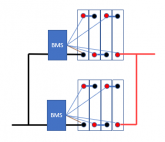FilterGuy
Solar Engineering Consultant - EG4 and Consumers
I just talked to Battery Hookup about this BMS and got a lot of great info.
(I am not in any way connected to Battery Hookup)
- They do parallel bank hookups all the time

- They tested one of these BMSs for a week at 100 amps without seeing a problem.
- He says he finds that the price of higher amp BMS goes up so fast that it is lower overall cost to do multiple parallel banks to get higher amps.
- They do not recommend serial bank hookups. (I did not get into why with him... I wish I would have) However, see next point.
- They expect to get an 8S version of these in in 2-3 weeks. The price should be less than $20 more.
- These BMS are being custom programed for Battery Hookup to get the low-temp cut-off. (He did not say this but that means if you buy from the manufacturer, you won't get the low temp shut-off. The link in an earlier post to the manufacturers site seems to confirm this)
- The manufacturer of this BMS is the same manufacturer that builds the BMS for Valence.
(I am not in any way connected to Battery Hookup)





